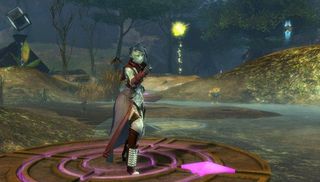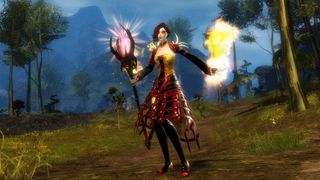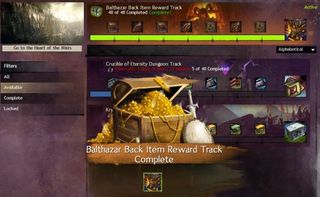Guild Wars 2's April Feature Pack represents an important soft overhaul for long-term players

Scarlet is dead, Mordremoth—the Elder forest dragon—has awoken, and Lion's Arch lies in ruins. More significantly, Guild Wars 2's player-base have completed an over year-long series of regular content releases, building to some of the most engaging and coordinated map-wide battles yet seen in the game. So what's next? For now, none of the above. Rather than hint at the content to come, the next update re-examines and overhauls many of the underlying systems. The April Feature Pack is due out later today, and could be a significant shift to how players engage with the game.
"I think over the last year you saw us integrate a lot of the features in with the content," Isaiah Cartwright, lead game designer for Guild Wars 2, tells me. "We did the whole achievement rework right at the same time as we had this big content patch. We found that they kind of step on each others toes. I think our philosophy now is trying to separate the features and the quality of life improvements from the content. This is our first run at that."
The phrase "quality of life improvements" comes up a few times in my talk with Cartwright, and, in most cases, it's apt. The contents of the Feature Pack were revealed one at a time, over a period of two weeks—giving even minor changes a chance to be highlighted by the developers and picked apart by the community. Whether it was the abolition of armour repair costs, the increased options being provided to guilds, or the game-changing "megaserver" overhaul; the slow reveal of each announcement turned an otherwise unsexy collection of disparate features into a release as anticipated as any new content.
"There's a lot of fun to experiencing these new systems," Cartwright says, talking about the slow reveal of these improvements. "For us it gives us a lot more focus. This one is really about this , so we can put it all together, test it in different ways, reveal it to people in different ways."

While the Feature Pack has no overriding theme, a few trends suggest how ArenaNet are responding to the preferences of their community. For all the lore and backstory that powers much of Guild Wars 2, its developers aren't afraid to accentuate its more game-like aspects. Currently, large zergs of players will roam the world, using API-driven websites to tell them when and where the game's giant World Bosses will spawn. As part of the megaserver switch, those timers are being formalised . There's no good reason why the game's most powerful monsters are showing up to a set schedule, other than that it makes things easier and better for those who enjoy that content.
A tweaked trait system will shift the focus away from set character progression, towards a flexibility that ArenaNet hope will encourage more build experimentation. Where once a character's traits—the passive bonuses that define their combat style—could only be changed by paying a specific NPC, with the feature pack they can be tweaked or reset on the fly. It's a system that finally acknowledges the difference between PvE, World vs World and dungeon content, and allows players to alter between specific styles as needed. While it's a nice change, I'm hoping it's the first step to a more fully-featured system—one that could allow for the creation of specific, pre-set loadouts of traits, skills and equipment that players could easily switch between.
Elsewhere, the patch seems to be encouraging alternate characters. Many of the game's most desirable items—from legendary weapons , to clothing dyes —will be made available across all accounts. A wardrobe system will also debut, creating an account-wide bank for the collection and transmutation of armour skins.
The biggest gaming news, reviews and hardware deals
Keep up to date with the most important stories and the best deals, as picked by the PC Gamer team.
"Some of the things we added for personal progression—legendaries or ascended items—we wanted them to take a while to accomplish," Cartwright says. "When you multiply that out to someone who has eight characters, it becomes quite daunting to do that same progression over and over again. By making things account bound, we make it a little easier. Even if you've got alts, you're still going to want more of the things, because passing one thing around can be tedious, but it gives you the option. If you want to play a character a bunch more, you shouldn't feel like you're starting over, or that all those hours you put into the game are not transferable between the different experiences.
"We're really hoping it's going to encourage alts, especially with account-bound World vs World experience and the dye system and the arts, all those things—the progression that you make on an account level is preserved. But there's still a lot to the character level, so we really hope it does encourage different builds and just interacting with the game in a different way."
Related to this are changes that won't be felt as heavily by level 80 characters. Traits are being hooked to specific open world events, encouraging new characters to explore and experience an increased breadth of lower-level events. But where some changes want to push players out into the world, others target specific preferences. The PvP reward system is changing to give rewards related to the game's dungeons. Players who prefer battling each other can now earn the same rewards as those who work to overcome the hardest PvE challenges.

For anyone starting out with a new or alternate character, ArenaNet are hoping that their new megaservers —initially rolling out on the lowest population zones—will ensure more lively maps. "Our goal is... if you went into Lion's Arch, you'd have a couple of hundred players on that map, and it always felt alive," says Cartwright. "With the new system, most maps should feel around that. There's not a single number that's going to be across all maps, but I think it'll make it so all maps will be equal in population. Even the map that has the least number of people right now will be completely filled."
In future, ArenaNet want these Feature Pack bundles to become a more regular thing, deploying between the more familiar content updates. "We're probably going to continue with that approach, because so far we've been very happy with it," says Cartwright. "We'll continue to monitor how well that's received, how well that works, and if splitting those up was a good thing or not. I think as we move forward that's our plan, is to continue along that pattern of "here's content; here's a bunch of new quality of life features", and keep that oscillating pattern going. As always, we'll change our pattern if we don't feel like it's going right, but that's our current thoughts at the moment.”

Phil has been writing for PC Gamer for nearly a decade, starting out as a freelance writer covering everything from free games to MMOs. He eventually joined full-time as a news writer, before moving to the magazine to review immersive sims, RPGs and Hitman games. Now he leads PC Gamer's UK team, but still sometimes finds the time to write about his ongoing obsessions with Destiny 2, GTA Online and Apex Legends. When he's not levelling up battle passes, he's checking out the latest tactics game or dipping back into Guild Wars 2. He's largely responsible for the whole Tub Geralt thing, but still isn't sorry.
Most Popular

